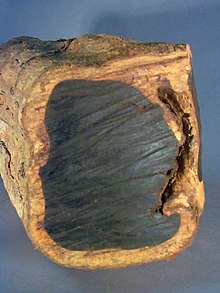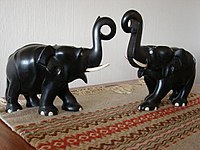Ebony

Ebonyis a dense black/brownhardwood,coming from several species in the genusDiospyros,which also includes thepersimmontree. A fewDiospyrosspecies, such as macassar and mun ebony, are dense enough to sink in water. Ebony is finely textured and has a mirror finish when polished, making it valuable as an ornamental wood.[1]It is often cited as one of the most expensive woods in the world.
Etymology[edit]
The wordebonycomes from theAncient Egyptianhbny,through theAncient Greekἔβενος(ébenos), intoLatin(ebenus) andMiddle English.[2]
Species[edit]
Species of ebony includeDiospyros ebenum(Ceylon ebony), native to southernIndiaandSri Lanka;D. crassiflora(Gabon ebony), native to westernAfrica;D. humilis(Queensland ebony), native toQueensland,theNorthern Territory,New GuineaandTimor;andD. celebica(Sulawesiebony), native toIndonesiaand prized for its luxuriant, multi-colored wood grain.Mauritiusebony,D. tessellaria,was largely exploited by theDutchin the 17th century. Some species in the genus yield an ebony with similar physical properties, but striped rather than the even black ofD. ebenum.
Uses[edit]
This sectionneeds additional citations forverification.(May 2024) |

Ebony has a long history of use, and carved pieces have been found inAncient Egyptiantombs.[3]
By the end of the 16th century, fine cabinets for the luxury trade were made of ebony inAntwerp.The wood's dense hardness lent itself to refined moldings framing finely detailed pictorial panels with carving in very low relief (bas-relief), usually of allegorical subjects, or with scenes taken from classical or Christian history. Within a short time, such cabinets were also being made inParis,where their makers became known asébénistes,which remains the French term for a cabinetmaker.

Modern uses are largely restricted to small items, such ascrucifixes,the main body of some musical instruments such as theclarinet,oboe,orpiccoloandmusical instrumentparts, including blackpiano,organ,andharpsichordkeys;violin,viola,mandolin,guitar,double bass,andcellofingerboards;tailpieces;tuning pegs;chinrests;andbow frogs.Manyplectrums,or guitar picks, are made from ebony.
Traditionally, blackchess pieceswere made from ebony, withboxwoodorivorybeing used for the white pieces. Modern East Midlands-style lace-makingbobbins,also being small, are often made of ebony and look particularly decorative when bound with brass or silver wire. Some expensivehandgun gripsandriflefore-end tips are still made of ebony, as are thebutts of pool cues.
As a result of unsustainable harvesting, many species yielding ebony are now considered threatened. Most indigenous ebony in Africa in particular has beencut down illegally.
Ebony is often cited as one of the most expensive woods in the world, along withAfrican blackwood,sandalwood,pink ivoryandagarwood.[4][5]
Protection[edit]
In 2011, theGibson Guitarcompany was raided by the USFish and Wildlife Servicefor violations of theLacey Act of 1900,which prohibits the illegal importation of threatened woods and other materials.[6]
An ebony androsewoodexpert at theMissouri Botanical Gardencalls the Madagascar wood trade the "equivalent of Africa'sblood diamonds".[7]
Gallery[edit]
-
Japaneseclothes brush
-
Kamagong (ebony) chair
-
Planks of wood includingGabon ebony
-
Violinfingerboardandtuning pegs
-
AGibson Les Paulguitar with an ebonyfretboard
-
APersian Tarhead with ebony
See also[edit]
References[edit]
- ^"Gaboon Ebony".www.wood-database.com/ Lumber Identification (Hardwoods).The Wood Database.Retrieved2016-12-11.
- ^Beekes, R. S. P.; van Beek, Lucien (2009).Etymological Dictionary of Greek.Leiden: Brill. p. 368.ISBN978-90-04-17418-4.
- ^D.M., Dixon (19 February 1961).The ebony trade of ancient Egypt.discovery.ucl.ac.uk(Doctoral).
- ^"Top 10 Most Expensive Woods in the World".Salpoente Boutique.18 November 2016.Retrieved19 September2020.
- ^"11 Most Expensive Woods in the World".Ventured.22 July 2020.Retrieved19 September2020.
- ^Fanelli, Damian (2012-08-07)."Gibson Agrees to Pay $350,000 in Penalties, Loses Seized Imported Ebony".guitarworld.Retrieved2023-01-07.
- ^Felten, Eric (August 26, 2011)."Guitar Frets: Environmental Enforcement Leaves Musicians in Fear".Wall Street Journal.Archivedfrom the original on October 6, 2015.







